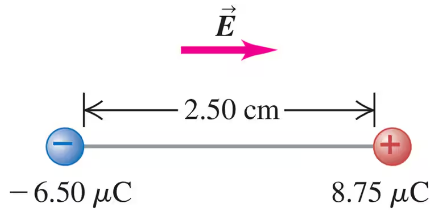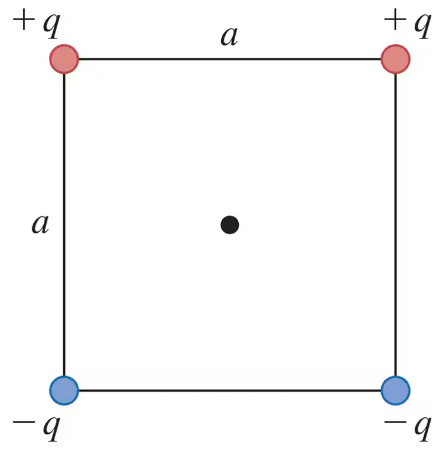 Back
BackProblem 2
Lightning occurs when there is a flow of electric charge (principally electrons) between the ground and a thundercloud. The maximum rate of charge flow in a lightning bolt is about C/s; this lasts for ms or less. How much charge flows between the ground and the cloud in this time? How many electrons flow during this time?
Problem 3
If a proton and an electron are released when they are m apart (a typical atomic distance), find the initial acceleration of each particle.
Problem 6
Two small spheres spaced cm apart have equal charge. How many excess electrons must be present on each sphere if the magnitude of the force of repulsion between them is N?
Problem 8a
Two small aluminum spheres, each having mass kg, are separated by cm. How many electrons does each sphere contain? (The atomic mass of aluminum is g/mol, and its atomic number is .)
Problem 8b
Two small aluminum spheres, each having mass kg, are separated by cm. How many electrons would have to be removed from one sphere and added to the other to cause an attractive force between the spheres of magnitude N (roughly ton)? Assume that the spheres may be treated as point charges.
Problem 8c
Two small aluminum spheres, each having mass kg, are separated by cm. What fraction of all the electrons in each sphere does this represent?
Problem 9a
Two small plastic spheres are given positive electric charges. When they are cm apart, the repulsive force between them has magnitude N. What is the charge on each sphere if the two charges are equal?
Problem 9b
Two small plastic spheres are given positive electric charges. When they are cm apart, the repulsive force between them has magnitude N. What is the charge on each sphere if one sphere has four times the charge of the other?
Problem 10
Suppose you had two small boxes, each containing g of protons.
(a) If one were placed on the moon by an astronaut and the other were left on the earth, and if they were connected by a very light (and very long!) string, what would be the tension in the string? Express your answer in newtons and in pounds. Do you need to take into account the gravitational forces of the earth and moon on the protons? Why?
(b) What gravitational force would each box of protons exert on the other box?
Problem 12b
The nuclei of large atoms, such as uranium, with protons, can be modeled as spherically symmetric spheres of charge. The radius of the uranium nucleus is approximately m. What magnitude of electric field does it produce at the distance of the electrons, which is about m?
Problem 13
Three point charges are arranged on a line. Charge nC and is at the origin. Charge nC and is at cm. Charge is at cm. What is (magnitude and sign) if the net force on is zero?
Problem 17
Three point charges are arranged along the -axis. Charge C is at the origin, and charge C is at m. Charge C. Where is located if the net force on is N in the -direction?
Problem 21a
A positive charge is fixed at the point , , and a negative charge is fixed at the point , . Show the positions of the charges in a diagram.
Problem 25a
A proton is traveling horizontally to the right at m/s. Find the magnitude and direction of the weakest electric field that can bring the proton uniformly to rest over a distance of cm.
Problem 25b
A proton is traveling horizontally to the right at m/s. How much time does it take the proton to stop after entering the field?
Problem 25c
A proton is traveling horizontally to the right at m/s. What minimum field (magnitude and direction) would be needed to stop an electron under the conditions of part (a)? Note: Part (a) asks for how much time does it take the proton to stop after entering the field.
Problem 28a
The earth has a net electric charge that causes a field at points near its surface equal to and directed in toward the center of the earth. What magnitude and sign of charge would a -kg human have to acquire to overcome his or her weight by the force exerted by the earth's electric field?
Problem 28b
The earth has a net electric charge that causes a field at points near its surface equal to and directed in toward the center of the earth. What would be the force of repulsion between two people each with the charge calculated in part (a) and separated by a distance of m? Is use of the earth's electric field a feasible means of flight? Why or why not? Note: Part (a) asked for what magnitude and sign of charge would a -kg human have to acquire to overcome his or her weight by the force exerted by the earth's electric field.
Problem 30a
Calculate the magnitude and direction (relative to the -axis) of the electric field in Example . Example : A point charge nC is located at the origin. Find the electric-field vector at the field point m, m.
Problem 32a
A uniform electric field exists in the region between two oppositely charged plane parallel plates. A proton is released from rest at the surface of the positively charged plate and strikes the surface of the opposite plate, cm distant from the first, in a time interval of s. Find the magnitude of the electric field.
Problem 32b
A uniform electric field exists in the region between two oppositely charged plane parallel plates. A proton is released from rest at the surface of the positively charged plate and strikes the surface of the opposite plate, cm distant from the first, in a time interval of s. Find the speed of the proton when it strikes the negatively charged plate.
Problem 34a
A -mC point charge is glued down on a horizontal frictionless table. It is tied to a -mC point charge by a light, nonconducting -cm wire. A uniform electric field of magnitude is directed parallel to the wire, as shown in Fig. E. Find the tension in the wire.
Problem 34b
A -mC point charge is glued down on a horizontal frictionless table. It is tied to a -mC point charge by a light, nonconducting -cm wire. A uniform electric field of magnitude is directed parallel to the wire, as shown in Fig. E. What would the tension be if both charges were negative?
Problem 37a
Two positive point charges are placed on the -axis, one at and one at . Find the magnitude and direction of the electric field at .
Problem 37b
Two positive point charges are placed on the -axis, one at and one at . Derive an expression for the electric field at points on the -axis. Use your result to graph the -component of the electric field as a function of , for values of between and .
Problem 40a
A -nC point charge is at the origin, and a second -nC point charge is on the -axis at m. Find the electric field (magnitude and direction) at each of the following points on the -axis: (i) m; (ii) m; (iii) m.
Problem 40b
A -nC point charge is at the origin, and a second -nC point charge is on the -axis at m. Find the net electric force that the two charges would exert on an electron placed at each point in part (a). Note: Part (a) asked to find the electric field (magnitude and direction) at each of the following points on the -axis: (i) m; (ii) m; (iii) m.
Problem 42
A point charge is placed at each corner of a square with side length . All charges have magnitude . Two of the charges are positive and two are negative (Fig. E). What is the direction of the net electric field at the center of the square due to the four charges, and what is its magnitude in terms of and ?
Problem 48
A point charge nC is at the point m, m, and a second point charge nC is at the point m, . Calculate the magnitude and direction of the net electric field at the origin due to these two point charges.
Problem 49d
A charge of nC is spread uniformly over the surface of one face of a nonconducting disk of radius cm. Why is the field in part (a) stronger than the field in part (b)? Why is the field in part (c) the strongest of the three fields? Note: Part (a) asked to find the magnitude and direction of the electric field this disk produces at a point on the axis of the disk a distance of cm from its center. Part (b) asked to find the magnitude and direction of the electric field at point , supposing that the charge were all pushed away from the center and distributed uniformly on the outer rim of the disk. Part (c) asked to find the magnitude and direction of the electric field at point if the charge is all brought to the center of the disk.


